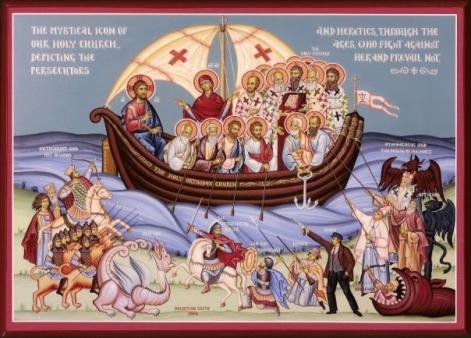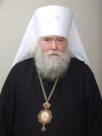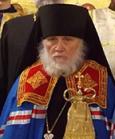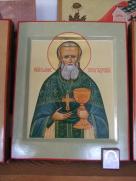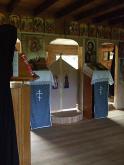Friday, February 20, 2015
Abbess Alexandra speaks about Saints John and Philaret
Abbess Alexandra of the St John Convent speaks about her spiritual fathers, Saint John of Shanghai and San Fransisco, and St Philaret of New York.
Wednesday, February 11, 2015
The three Holy Hierarchs in humbling conditions
The three holy hierarchs, St Basil the Great, St Gregory the Theologian, and St John Chrysostom, lived in times of great turmoil for the Church. Although there was no more persecution from pagans, heretics and Christians of weak faith and poor moral standards stood up against the holy ones.
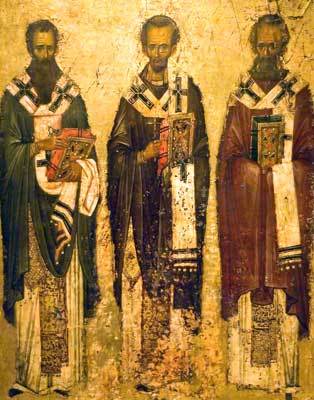 In AD379, when the faithful in Constantinople talked St Gregory the Theologian into becoming their bishop, the Orthodox had no churches in the capital city. The Arian heretics held them all.
In AD379, when the faithful in Constantinople talked St Gregory the Theologian into becoming their bishop, the Orthodox had no churches in the capital city. The Arian heretics held them all.
St Gregory stayed with a relative in the city, and converted one of the rooms of his relative’s house into a Church, dedicated to the Resurrection, not only of Christ our Lord, but also, the resurrection of Orthodoxy. By fervent prayer, daily services, and daily instructional sermons, St Gregory began to convert the city back to Orthodoxy. But it was not easy.
In the midst of wolves I built up a congregation
St Gregory the Theologian, 4th century
St John Chrysostom suffered many unjust accusations, exile and death in a strange land without support because he offended the vanity of the Empress and many less than virtuous clergymen. Councils even anathematised the holy man!
….he, hurrying on to the completion of his design, although we had declared our readiness to clear ourselves of the charges in the presence of a hundred yea or a thousand bishops, and to prove ourselves innocent as indeed we are, would not consent: but in our absence, when we were appealing to a synod, and demanding a trial, and not shrinking from a hearing of our cause, but only from open enmity, he both received our accusers and absolved those who had been excommunicated by me, and from them, who had not yet cleared themselves of the offences laid to their charge, he received complaints against me, and had minutes made of the proceedings, all which things are contrary to law, and the order of the canons. But what need is there of a long story? He did not cease doing and contriving everything until, with all possible display of arbitrary power and authority, he ejected us from the city and the church, when the evening was far advanced and all the people were streaming after us. Being drawn by the public informer through the midst of the city, and dragged along by force I was taken down to the sea, and thrust on board ship, and made a night voyage, because I appealed to a synod for a just hearing of my cause. Who could hear these things without tears, even if he had a heart of stone?
St John Chrysostom, 4th century
St Basil the Great also experienced ill treatment from heretics, and described the persecution as harder to bear than what the martyrs endured from the pagans before:
In my judgement, the war that is waged against us by our fellow countrymen is the hardest to bear, because against open and declared enemies it is easy to defend ourselves, while now we are necessarily at the mercy of those who are associated with us, and are thus exposed to continual danger….Our father were persecuted, but by idolators…The persecutors, who have lately appeared, hate us no less than they, but, to the deceiving of many, they put forward the name of Christ, that the persecuted may be robbed of all comfort from its confession, because the majority of the simpler folk, while admitting that we are being wronged, are unwilling to reckon our death for the truth’s sake to be martyrdom. I am therefore persuaded that the reward in store from the righteous Judge is greater than that bestowed on the former martyrs. They indeed both had the public praise of men, and received the reward of God; to you, though your good deeds are not less, no honours are given by the people. It is only fair that the requital in store for you in the world to come should be far greater….I exhort you, therefore, not to faint in your afflictions, but to be revived by God’s love, and to add daily to your zeal, knowing that in you ought to be preserved that remnant of true religion which the Lord will find when He comes on earth….If traitors have arisen from among the clergy themselves, let not this undermine your confidence in God. We are saved not by names, but by mind and purpose, and genuine love toward our Creator….Remember that it is not the multitude who are being saved, but the elect of God…If but one be saved, like Lot at Sodom, he ought to abide in right judgement, keeping his hope in Christ unshaken, for the Lord will not forsake His holy ones.
St Basil the Great, 4th century
In view of the lives of the three holy hierarchs, is there any reason for the Orthodox today to fear? No longer does the Arian heresy trouble the Church (although it still exists in a different form). Today, it is the heresy of Ecumenism that is the greatest threat. The true Orthodox understand that in abstaining from communion with heretics, in attending humble house-churches instead of glorious cathedrals, they are indeed following in the footsteps of the saints!
O Holy Hierarchs, Basil the Great, Gregory the Theologian, and John Chrysostom! Strengthen all the Orthodox, console and uplift us! Make us firm on the path of salvation through suffering for Christ, in cleansing ourselves from sin through sincere repentance, and struggling for piety by fulfilling His commandments!
Tuesday, December 2, 2014
Saints glorified in our Greek Sister Church
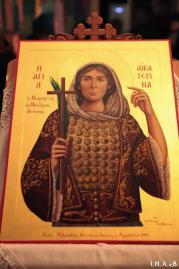
The Church of the True Orthodox Christians of Greece has glorified two Saints:
The Martyr Catherine (Routtes), who suffered for the traditional Church calendar very soon after the introduction of the “new calendar” and the Venerable Father Pachomios of Chios, a monk who reposed in peace.
Read the announcements of the Greek Synod regarding Saint Catherine and Venerable Pachomios
A life of Saint Catherine in English.
 Holy New Martyr Catherine and Venerable Father Pachomios, pray to God for us!
Holy New Martyr Catherine and Venerable Father Pachomios, pray to God for us!
More information regarding the method of recognition of Saints in the Orthodox Church is found here.
Source and second source
Thursday, August 28, 2014
Dormition of the Most-Holy Mother of God
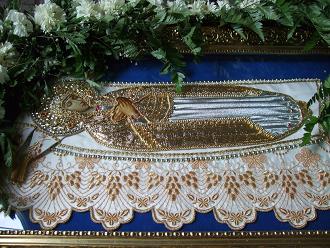 The Mother of God is translated from earth to Heaven. Instead of sorrow, her death brings the Apostles and all the faithful for all time unexpected JOY. She goes to be with her Son, just as every pious Christian who has lived his life worthily will go to be with Him when they die. And She, who is closest of all created beings to Her Son, prays for us continually:
The Mother of God is translated from earth to Heaven. Instead of sorrow, her death brings the Apostles and all the faithful for all time unexpected JOY. She goes to be with her Son, just as every pious Christian who has lived his life worthily will go to be with Him when they die. And She, who is closest of all created beings to Her Son, prays for us continually:
Neither the tomb nor death had power over the Theotokos, who is ever watchful in her prayers and in whose intercession lies unfailing hope. For as the Mother of Life she has been transported into life by Him who dwelt within her ever-virgin womb. Kondak of the feast of Dormition
The Mother of God is holy because She contained within herself the Creator of everything…however, She was a human, born into the same sinful world as us. Instead of choosing sin, She chose virtue in every circumstance, struggling successfully against every temptation in life.
For He hath regarded the low estate of His handmaiden…for, behold, from henceforth all generations shall call me blessed. For He that is mighty hath done to me great things; and holy is His name. And His mercy is on them that fear Him from generation to generation. Lk1:48-50
These are not simply excited words of happiness, nor guesswork, or accidental foreboding but rather, prophesies in the most exact sense of the word. It is the word of the Holy Spirit in the mouth of Mary, the announcement of God’s providential will for her destiny, and about our obligations to her.
We see that the holy Virgin, after the announcement of Archangel Gabriel, went to the house of Zacharias. What does that home signify? That home is blessed by deeds of piety. It is a home where God is known, which honours Him with reverence and diligently serves Him. In it She will see nothing but examples that awaken, strengthen and support Her zealousness and piety. This is the company the holy Virgin seeks.
What should we conclude from this? That we in our acquaintances need to be extremely careful. In our choice of friends we need to look not at status, merit, or nationality, nor at importance or riches, nor at the glamour of fortune, nor at natural capabilities, nor at lively character, nor at a person’s extensive mind and fame, but rather - at the person’s virtue and committed life, at their piety, at their righteous soul, purity of heart and chaste morals.
I have chosen rather to be an outcast in the house of my God, than to dwell in the tents of sinners. Psalm 83:11
So says King and Prophet David about himself. Here is the example by which we must evaluate homes and friends, and thus distinguish with whom we can or cannot have close relationships.
If sinners have distanced themselves from the Lord; then it is to our profit and our responsibility to distance ourselves from them. This does not mean being unfriendly or lack of love towards sinners - it simply means that sinners should not be our close ones - they should not have an insight into the treasure of our soul.
Let our true friendships rather be with Christians, with people fully devoted to God, Whom we must love above all and more than everything.
Where do we find such friends? God might grant us to find them in unexpected places - but they are more likely found in the Church community than in the secular world. However, even in the Church community, people have advanced in their spiritual life to different degrees. We should emulate the perfect, and at the same time remain loving toward all, including those making their first, perhaps clumsy steps in the faith.
Let us notice, also, that the holy Virgin Mary places her joy in God, rather than in her friends and relatives, whom she was with at this time:
And my spirit hath rejoiced in God my Saviour. Lk1:47
Let the example of the Mother of God teach us to place our joy in God alone. For He is the highest perfection of Good and the Source of all happiness. He sent His only Son, our Lord Jesus Christ from heaven to earth, in order to avert men’s hearts from the vanities of this world and to attract them to Himself. By these means He wishes to make all people partakers of His own goodness.
Therefore, we need to search for happiness, not for the flesh and blood, but for the soul. We should not busy ourselves too much with gathering earthly acquisitions or earthly, worldly friendships. Rather, we should concentrate on acquiring heavenly treasures. This mystical treasure will be ours to see after we die - just as the Mother of God found Her treasure when She died. She died bodily, like any earthborn person - but after three days, Her body was no longer found in the tomb, as testified by the Holy Apostles and written about by the very early Church Fathers. Her many appearances and tangible help to Christians from the time of the Apostles to this very day are the proof Orthodox Christians hold of Her greatness in the work of the Providence of God. After God, She is our greatest friend and helper!
Sunday, July 27, 2014
Sermon on the Sunday of the first Six Ecumenical Councils
ORTHODOXY means “right glorification” (of God), correct faith. The correct faith, as defined by the Holy Church - that faith defines how we believe.
The essence of Orthodoxy is NOT things like having gold cupolas, having an iconostasis, having no church seats…! These things are part of Church tradition, and may assist our faith, but they have had various forms in various times and places.
The correct faith was defined at the seven Ecumenical Councils. These gatherings of Bishops discussed and condemned certain teachings which were disturbing Christians at various times in history. These non-Orthodox teachings are called heresies. A heresy is an ERROR in faith, or an incorrect teaching.
These Ecumenical Councils defined the basics tenets (called dogmas) of the Orthodox faith.
In addition to the Councils, the Orthodox faith is informed by the Holy Scriptures (the Bible) and the Church Tradition as taught and lived by the Holy Fathers of the Church.
1. In the 4th century, 300 bishops met and refuted Heresy of Arius against the Son of God.
The Arians believed that Son of God is created, that is, that he is a man and not truly God. They believed that Jesus Christ is NOT equal with God the Father.
It is interesting to note that many modern protestants see Jesus Christ in a similar way to the Arians – as a great moral teacher, a good man, or their personal friend. The manner of addressing God is coloured by this perception of Christ as “one of us, a man”.
Many later Christian Groups, such as MORMONS, the “Church of God”, and Jehovas Witnesses, hold more or less Arian views of our Lord Jesus Christ.
We Orthodox, in contrast, believe that Jesus Christ truly is God AND man.
2. Once again, in the 4th century, 150 bishops met and refuted the heresy of Macedonius against God the Holy Spirit.
The Macedonians believed that the Holy Spirit is NOT equal with God the Father.
This council also reaffirmed the Creed of Faith, which Orthodox Christians recite every day.
It is interesting to note that many years later, the Roman Catholic church changed the Creed of Faith precisely in its explanation of the Holy Spirit. Instead of teaching that the Holy Spirit proceeds from the Father, the Roman Catholic church teaches that the Holy Spirit proceeds from the Father AND the Son – in essence, making the Holy Spirit lower than the Father and the Son.
In contrast, we Orthodox believe that the Holy Spirit is equal with the Father and the Son.
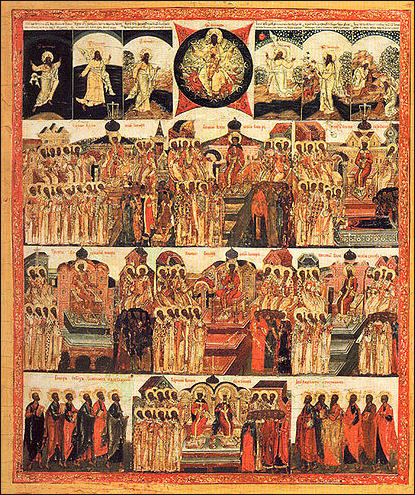
3. In the 5th century, 200 bishops met and refuted the heresy of Nestorius against the Mother of God.
The Nestorians believed that the Holy Virgin Mary should not be called “Theotokos”, but rather, only “Christotokos” – that is, birthgiver of Christ, but not of God. This teaching makes it unclear whether Jesus Christ, from the moment of conception, really was God!
From the beginning of the protestant faiths, they have been reluctant to give the honour of the name “Birthgiver of God” to the Most-Holy Virgin. Many protestants do not believe that the Virgin Mary remained a Virgin before, during, and after childbirth.
In contrast, the Orthodox faith teaches that the Most-Holy Virgin is holier than all the saints, because she fully contained within Herself and gave birth to – GOD the SON!
4. In the 5th century, 600 bishops refuted the monophysite heresy.
The monophysites believed Christ had only ONE nature – the DIVINE nature. They believed His human nature was absorbed in His Divine nature.
To this days, the Coptic “Orthodox”, Syrian “Orthodox”, and Armenian “Orthodox” have not renounced this belief.
The Orthodox believe that Christ had two natures, both Divine and human – otherwise, it would follow that the divine nature suffered on the Cross – something which is not possible for the unchangeable God.
5. In the 6th century, 160 bishops refuted the heresy of Origen.
This belief holds that ‘everyone is saved’ or ultimate universal salvation, regardless of faith and life. It is a very MODERN VIEW of faith, which we encounter every day in the modern society we live in.
The Orthodox faith is very different from this modern indifference – it requires a specific faith, and a specific practice, and sincere repentance wherever a person falls short of the ideal
6. In the 7th century, 170 bishops refuted the monothelite heresy.
The monothelites believed that Christ had ONLY one will - the Divine Will (NOT 2 wills as in Orthodoxy). The famous Saint MAXIMOS the Confessor suffered much, and finally had his tongue cut out because of his stance against this heresy. St Maximos was a simple monk, who taught the correct faith, acting against Emperors, Patriarchs, and Bishops who had accepted the non-Orthodox belief. As he was not even a priest, but only a simple monk, he is an example of what courage, firmness, and knowledge every lay person should have in keeping the Orthodox faith.
7. In the 8th century, 360 bishops met and refuted iconoclasm.
The iconoclasts believed we should not make icons of Christ, the Mother of God, or the saints. This heresy disturbed the Church from more than a hundred years. There were martyrs for the icons, icons were destroyed, and the whole Byzantine empire was implicated.
ALL these Heresies produced thousands of martyrs. Orthodox faithful were killed for refusing to accept these new distorted and altered forms of faith. To this day the TRUE Orthodox Church believes that these Church Councils, through the operation of the Holy Spirit condemned and judged these Heresies, and the ORTHODOX FAITH was defined and confirmed for all time.
YOU are not Orthodox unless you believe according to the Holy Ecumenical Councils. But this is not all – you must also make sure your Bishop believes according to the Seven Ecumenical Councils. This is because the BISHOP is the head of the local Church. How the Bishop BELIEVES is how the Church BELIEVES.
According to the LAWS (the Canons) of the 7 Ecumenical Councils:
1. An Orthodox Christian cannot leave his bishop….EXCEPT if the Bishop is in heresy.
2. An Orthodox MUST, or is obliged to leave his Bishop if he is in heresy.
On this basis people like us left ROCOR(MP) in 2007 when it joined the Moscow Patriarchate (MP), because this organisation fully participates in the World Council of Churches (WCC), and through it, in ECUMENISM – a teaching which has been defined by Church fathers as heresy of heresies.
All the ‘mainstream’ Orthodox bishops who participate in the WCC, and the Churches they represent, do not truly follow the decisions, Canons, ands Laws of the seven Ecumenical Councils. They have signed documents to be ONE with the very heretics condemned by these Councils!
For example, well-known bishops (even patriarchs!) publicly pray with not only Monophysites and Catholics, but also with pagans and Jews. Prayer together with people who believe entirely differently is not allowed for Orthodox people. Therefore, such hierarchs have put themselves outside the Orthodox Church - and no sincere Christian can follow them.
Roman Catholics recognise another 20 Councils as Ecumenical. One of their most recent councils teaches that the Pope of Rome, when he speaks ‘ex cathedra’ is sinless. As mentioned above, they also changed the Symbol of Faith from the 2nd Ecumenical Council.
Protestants and later Christian Sects descended from the Protestants do not acknowledge ANY Ecumenical Councils. This is interesting because the composition of books in Holy Scripture (which they regard as their sole source of authority) was finally decided only in the 6 Century, at the 6th Ecumenical Council (!)
Many of the Heresies of the first Centuries were widespread, lasted a long time, and caused tremendous disruption in Church and political life, with great loss of innocent life. ‘Everyone’ was a heretic. The vast majority of people were in the glorious big churches. The true Orthodox were suffering, persecuted and often tortured and killed, by people who a short while before attended the same church as them!!
The True Orthodox had to gather in Catacombs, and make-do churches anywhere they could.
There is nothing new about the majority being in heresy, and this majority persecuting the few faithful people.
In our times what is most dangerous for us is the entry of Orthodox Churches into the ecumenical movement. This means their acceptance of a Protestant ecumenical understanding of the Church. Such an understanding in reality is already spoken of at meetings and printed in the books of Orthodox ecumenists. Together with the breakdown of an authentic Orthodox understanding of the Church we find an undermining of the meaning of the Ecumenical Councils which means a consequent loss in the firmness of the Council’s dogmas. As a result, the very foundation of Orthodoxy is undermined. ( Protopresbyter Michael Pomazansky. From Orthodox Life, No.1, 1989.)
However, we must understand that the heretic, non-Orthodox Christians are not necessarily “bad people” – but they are not Orthodox. They are not in God’s Church.
We should pray for them and feel sorry for them – bring them to Orthodoxy, by our example faith and life. Those who have left the Orthodox Church, or who entertain non-Orthodox teachings while still outwardly appearing to be “orthodox” are the poorest of the poor – for they have lost their salvation through the Holy Orthodox Church!
Dear brothers and sisters…..we must RUN to the MOTHER OF GOD for help, as the Orthodox Christians always have done.
She will protect, guide and help us. She is our help and Protectress.
Incorrect belief and distortion of Orthodox faith (as defined by the seven Ecumenical Councils), is a spiritual sickness. People who have stopped running to the Mother of God for guidance and help …..eventually end up in incorrect belief, or even no belief or faith. Some even start persecuting the true faith.
Let us pray especially for the younger generations, our children, and their children who will need even more help to survive in our increasingly antichristian world. Amen.
Friday, July 25, 2014
The Troeruchitsa Icon of the Most-Holy Mother of God
Today, the Holy Church celebrates the Icon of the Most-Holy Mother of God called the Troeruchitsa, or “the one with Three Hands”. This Icon has an interesting history.
Akathist to the Troeruchitsa Icon (in Serbian) - parish of St John of Kronstadt in Sydney.
Akathist text in Slavonic (Russian letters)
Akathist text in English
When saint John Damascene functioned as advisor to the Caliph of Damascus in Syria, he once fell into disfavour. This happened because Emperor Leo the Isaurian of Byzantium, the iconoclast, slandered him before the Arab ruler. The Caliph did not understand the internal affairs of Christians, and did not know that Leo actually had left the Orthodox faith. Emperor Leo was now battling against the veneration of icons, and against anyone who defended the Icons. The empire was troubled to an incredible degree - icons were burned and painted over, and brothers fought their own brothers because of the icons. The Orthodox people were forced to pray in make-shift churches and homes, as the iconoclasts took over more and more of the ancient churches. St John was among these pious and persecuted Orthodox Christians.
As a result of this slander, the ruler had St John’s hand cut off. He even displayed the hand publicly in the city as an example for all.
However, with God’s help, friends of St John at the court were able to obtain the cut-off hand. He took the hand to his private prayer chamber, and poured out his grief to the Mother of God. He asked for healing - a healing which would strengthen the Orthodox against the heretic iconoclasts (icon-fighters).
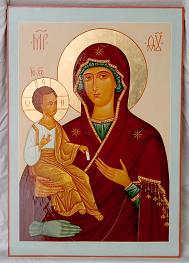 And the Mother of God heard him!
And the Mother of God heard him!
She appeared in a dream to St John. She demanded that he fulfill his promise, now that he had been healed. Seeing the now healthy hand (only a fine line remained where it had been cut off, as a memory), and touched to his innermost parts, St John had a silver hand made, which he fastened to his icon of the Mother of God. This is how it came to be known as the “three-handed” icon.
All of Damascus was similarly amazed, as was the ruler. He loved St John even more than before. Only after a long time he reluctantly allowed St John to leave his service, to become a monk at the monastery of St Savva the Sanctified in Palestine, as he had promised to the Mother of God.
Many years later, St Savva of Serbia arrived at the monastery, and was given this holy Icon as a blessing, as the Mother of God Herself blessed. The Icon remained in Serbia for a long time. However, when unrest arose in the country, it was decided to allow the Mother of God to go wherever She wished. Her Icon was put on a donkey’s back, which was carefully observed to see where She would direct it. Without any kind of intervention from people, the donkey went directly to Mount Athos, where it stopped at the Hilandar monastery. The brothers met the Icon of the Mother of God with reverence.
After the death of the Abbott, the brothers at Hilandar were in discord. However, the Mother of God saved them from internal enmity by taking upon Herself the place of Abbess of this monastery. She did this by repeatedly moving the Icon to the Abbott’s throne in the monastery church - despite the brothers repeatedly moving it back to its usual place. Finally, the brothers understood the Mother of God’s will, and since then to this very day, they do not elect an Abbott, but only a prior (namestnik).
In the 19th centrury, Russian master goldsmiths from St Petersburg made a beautiful riza for the Icon, which also depicts the venerable saint Simeon the Mhyrr-gusher, father of St Savva of Serbia. On the back side of the Icon, there is an icon of St Nicholas.
The Mother of God has saved not only the Hilandar monastery, but also, an innumerable number of Orthodox Christians from every kind of trouble over the centuries. Very recently, the monastery was saved from fire by Her intercession.
Let us pray to the Mother of God, brothers and sisters, to save us from danger, sickness, persecution from outsiders, heresy, and from internal discord! Only by Her help and protection are we able to reach our true home - the Heavenly Jerusalem and the Church triumphant!
Wednesday, July 16, 2014
Sts Peter and Paul
Of all the apostles the Church especially lauds Saints Peter and Paul, calling them glorious and all-praised leaders of the apostles. One of the four yearly fasts is also called by the name of one of these apostles and ends on their feast day.
Such great honor is proffered them for their great spiritual labors in the field of preaching the Gospel. Even such a prominent Church Father as St. John Chrysostom hesitates in giving preference to one or the other of them, frequently calling them pillars of the Church. The entire book of the Acts of the Apostles chiefly describes the work of the Apostles Peter and Paul in spreading the Gospel. It is interesting to note that Peter and Paul came from totally opposite wakes of life: Apostle Peter was poor and uneducated, while Apostle Paul came from a wealthy family and had a first-rate education for those times. The grace of God that illuminated both apostles shone forth equally from both of them, which leads one to think that our earthly provenance has no significance in the face of eternity. The words of our Lord Jesus Christ come to mind, that “God is able out of these stones to raise up children unto Abraham” (Luke 3:8).
The holy Apostle Peter, a native of the city of Bethsaida and older brother of the first-called Apostle Andrew, was a man of ardent and impulsive nature, illiterate, a simple and God-fearing fisherman. At the Lord’s first summons he left his fishing nets and followed Christ. The Lord always distinguished Peter for his loyalty: he was a witness to Christ’s Divine glory during the Transfiguration on Mount Tabor, he also witnessed the resurrection of the daughter of Jairus, by God’s will he walked on the waters of the lake of Gennesaret. St. Peter earned the Lord’s favor by being the first, on behalf of the apostles, to confess Jesus Christ as the Son of God. However, Peter’s strong confession of the Lord as the Son of God did not subsequently prevent him from thrice renouncing his Teacher in the night of Judas’ betrayal. But this apostasy of Peter’s was expiated by his sincere repentance, and the Lord reinstated him in his apostolic dignity, as described by the Holy Evangelist John (21:15-17).
By the way, this place in the Gospel where the Lord reinstates Peter in his apostolic dignity, from which he fell through his renunciation, is wrongly interpreted by the Roman-Catholic Church as referring to the supremacy of Peter and the Roman bishops, i.e. the primacy of Roman popes.
After his reinstatement Peter remained steadfast in faith, and on the day of the Pentecost preached an inspired sermon that resulted in the conversion of several thousand people to Christ. His sermons were often accompanied by miracles, which made his words irrefutably convincing. Even the shadow of Apostle Peter miraculously healed the sick (Acts 5:15). Among the other apostles Peter enjoyed the primacy of honor, but not power. All decisions regarding the affairs of the Church he offered for examination to the council of the apostles, which sent him out on a par with other apostles to preach the Gospel, while Apostle Paul even contradicted him on several issues (Gal. 2:11).
Peter made six journeys throughout Asia Minor and wrote two epistles for fortifying the faithful, which are used in church services to this day. After the Dormition of the Holy Mother of God, Peter made his last journey from Jerusalem, traveling through Egypt, Britain, Greece, and arriving in Rome in A.D. 67. Here he converted to Christianity two favorite wives of Emperor Nero, who condemned St. Peter to crucifixion for this and for generally preaching Christianity in Rome.
The holy Apostle Paul (Saul), a native of the city of Tarsus, was a Jew from the tribe of Benjamin, and a Roman citizen by the merits of his ancestors, which was a rare combination at that time. He received a brilliant education in the school of the famous Jewish teacher Gamaliel and was educated as a Pharisee. The ardor of Saul (as he was called before conversion to Christianity) for Jewish law was so great that he hated Christians and persecuted them in all possible ways. He tormented the Church of Christ and was a great persecutor of Christians. But then the grace of God touched even him: on the road to Damascus, where he was traveling to engage in greater tormenting of Christians, the Lord appeared to him and summoned him to serve the Church. And thus from Saul, the persecutor of Christians, in a single moment he turned into Paul, one of the most fervent apostles of Christ. He traveled more than all the others to preach the Gospel. Three times he circled almost the entire Roman Empire. He wrote the greatest number of epistles – 14. He took part in the apostolic council. The holy apostle’s life was spent in constant travels through Asia Minor, Greece, and other parts of the Roman Empire, ending with the city of Rome, where he ended his life in A.D. 67 in the reign of Emperor Nero, being beheaded since he was a Roman citizen. His 14 epistles are comprised in the New Testament (as are the two epistles of Apostle Peter) and are used in church services year-round.
How much faith, love for God and their fellow-men, and loyalty to God’s will lived in the souls of the holy Apostles Peter and Paul! They spread the glad tidings into all the corners of the world, baptizing all peoples, suffering heat and cold, thirst and hunger, persecution and torture, – just to serve the great effort of the salvation of mankind! The entire universe of those days was filled with their preaching. Truly the prophetic words of King David came to pass: “Their line is gone out through all the earth, and their words to the end of the world” (Psalms 19:4).
Protopriest Igor Hrebinka (Bishop Joseph)
